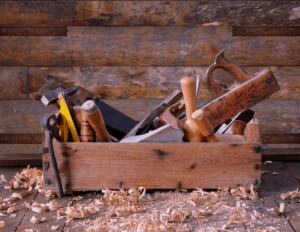What's in your Practice Toolbox?
 In this busy life and busy world, it can be challenging to have and maintain clarity about what we are doing and why. This is true in our work and home lives and also in our practice.
In this busy life and busy world, it can be challenging to have and maintain clarity about what we are doing and why. This is true in our work and home lives and also in our practice.
Having an assortment of practice tools to engage with and choose from to meet the varied requirements of a life can help. Every practitioner needs a toolbox. Zen may feel very systematized – we all walk and bow together, wear samue or robes, shape our bodies to sit a certain way, eat oryoki, the list goes on, but even within that level of conformity, each heart/mind is distinct unto itself.
Indeed, the frontiers of the mind are boundless and what’s happening in the heart, minds and bodies of each individual is, firstly, totally unknowable by anyone else, and also completely unique to each person. Each practice toolbox will be distinct to each person.
What is the value of having a personalized toolbox? This extends far beyond the cushion. Having a toolbox means we can take our practice with us wherever we go. Do you have a ‘waiting in the grocery store line’ practice? Or how about a ‘walking across the parking lot practice?’
How can we carry presence with us, throughout the day, in all of our various modes? As we drive and shop, cook and clean, take care of our families and attend to work, how do we build a practice toolbox that meets the demands of our daily life on and off the cushion?
This is a way to bring practice to life, to feed it, to make it our pivot point. Staying curious is essential. And being creative about how to make it work within a life can be a great challenge and also a great joy. Otherwise, we tend to slip into default mode.
 This is particularly apparent in our current era of infinite content being beamed into our cellphones and computers. Default mode often includes staring blankly into a small screen. Some call it doom scrolling.
This is particularly apparent in our current era of infinite content being beamed into our cellphones and computers. Default mode often includes staring blankly into a small screen. Some call it doom scrolling.
Toolboxes bring choice and choice brings freedom. Instead of remaining in default mode all day and only remembering to practice when we sit in a particular way and wear particular clothes and have a special bell, We can cultivate practices that can be utilized wherever we go.
Inserting a practice wedge in the moments we are most inclined to fall into default mode can be an extremely helpful habit to cultivate.
What is your first impulse when you arrive home from work or an errand? What about taking a deep breath before you open the door to your living space? One of my favorite practice tools is to take a breath and say ‘yes’ before I open a door. Whatever is on the other side, yes, I will meet it with whatever level of presence and clarity I have available.
Keep it simple. What makes sense in your own life? Reading the sutras and listening podcasts can be important and opening but we also need to trust our own inner teacher. We also need to decide how we will actually live this practice life, moment to moment. There isn’t time to wait for more auspicious circumstances to practice.
Where practice will take us is a mystery. This practice is not about making the inconceivable finally conceivable. It’s lovely that mindfulness reduces stress, calms the mind, and helps us find healthier and happier ways to engage with our emotions.
 Those benefits of mindfulness are all wonderful and important. Practice is also an entryway to wonderment. When we are more present with our lives, the really interesting questions are given space to emerge and settle into the foreground. What is alive? Who am I? Is there a source of all things? How is it that I am anything at all?!
Those benefits of mindfulness are all wonderful and important. Practice is also an entryway to wonderment. When we are more present with our lives, the really interesting questions are given space to emerge and settle into the foreground. What is alive? Who am I? Is there a source of all things? How is it that I am anything at all?!
One step at a time, one doorway at a time, open the mind and see what catches you! Kawabanga! With mindfulness, step by step, we dive right in!
